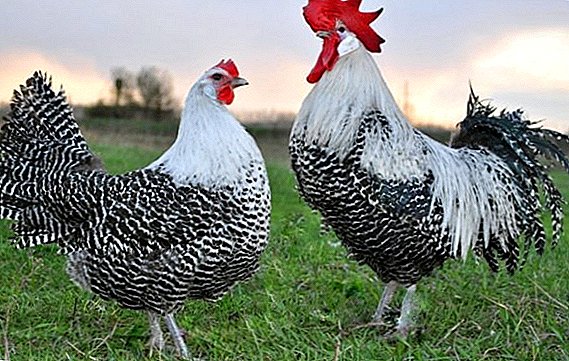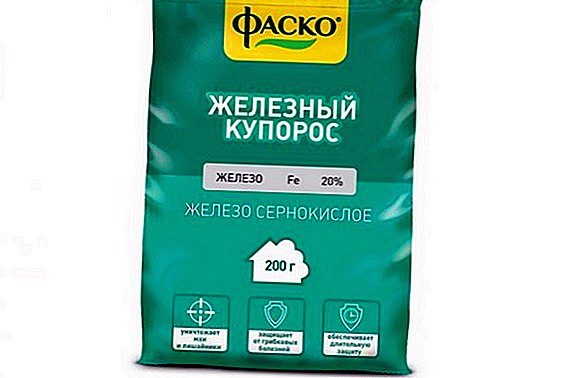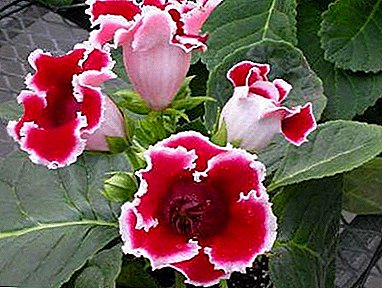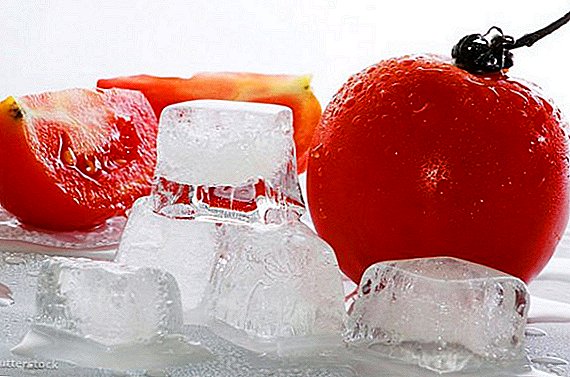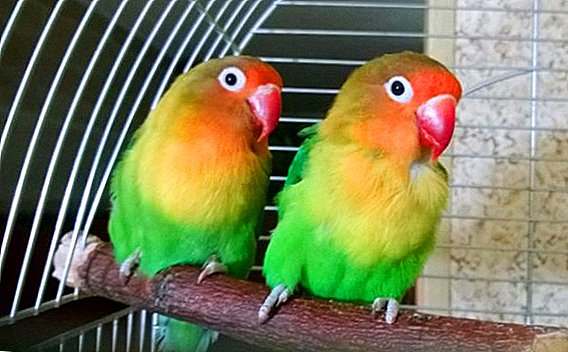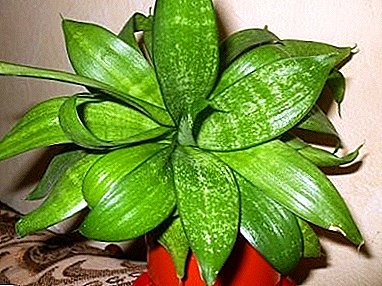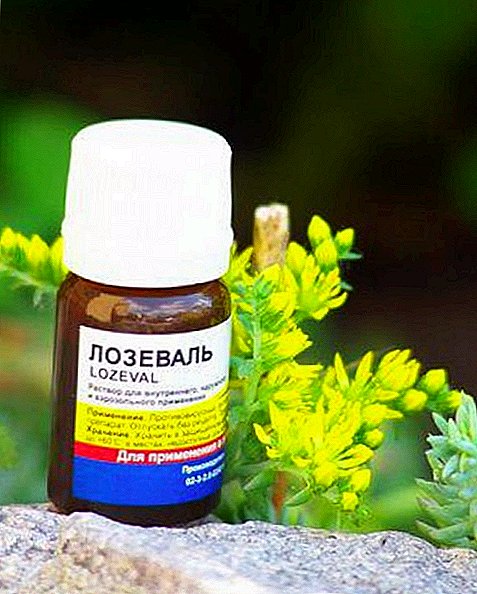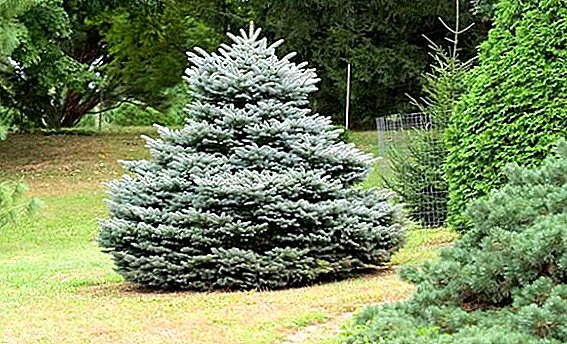 The well-known blue spruce is also scientifically called spruce (Latin. Pīcea pūngens). This coniferous evergreen tree. It grows wonderfully in our latitudes, but it came to us from the US states of Arizona, New Mexico, Idaho, Colorado and Utah and is a tree-symbol of the last two. Description spruce spruce start with the fact that the maximum known height of 46 meters. In nature, it usually ranges from 20 to 30 meters. The color of the needles can be from gray-green to blue with a needle length from 15 to 30 centimeters. Seeds about 3 centimeters, with a wing up to 13 cm, ripen in light brown cones up to 11 cm in size and 2 cm wide. Spruce spruce is widely used in ornamental horticulture, therefore let's take a closer look at its most interesting varieties, which today are over 60.
The well-known blue spruce is also scientifically called spruce (Latin. Pīcea pūngens). This coniferous evergreen tree. It grows wonderfully in our latitudes, but it came to us from the US states of Arizona, New Mexico, Idaho, Colorado and Utah and is a tree-symbol of the last two. Description spruce spruce start with the fact that the maximum known height of 46 meters. In nature, it usually ranges from 20 to 30 meters. The color of the needles can be from gray-green to blue with a needle length from 15 to 30 centimeters. Seeds about 3 centimeters, with a wing up to 13 cm, ripen in light brown cones up to 11 cm in size and 2 cm wide. Spruce spruce is widely used in ornamental horticulture, therefore let's take a closer look at its most interesting varieties, which today are over 60.
Glauka Globoza
Glauca globosa - dwarf variety of spiny spruce, which was taken out of seeds in 1937 from Ant Kluisa. It is rather a shrub than a tree, the trunk is not visible, up to 2 meters high and up to 3 meters wide.
She has an unusual crown - in the form of a ball or kolonovidnaya, and over time it can take the form of a triangle, the branches are located rather densely.  The shoots of the spruce Glauka Globoza are usually 9–12 centimeters in length and 1 cm in width of an unusual silver color with a blueness; they grow to a maximum of 5 centimeters per year.
The shoots of the spruce Glauka Globoza are usually 9–12 centimeters in length and 1 cm in width of an unusual silver color with a blueness; they grow to a maximum of 5 centimeters per year.
They seem to have some kind of sputtering. Elongated brown cones resemble Christmas toys. The plant is completely unpretentious, can grow in any soils of moderate humidity, loves sunlight, frost.  In early spring, when the soil does not dissolve, and the sun is bright, it is likely that the needles burn, especially in young plants.
In early spring, when the soil does not dissolve, and the sun is bright, it is likely that the needles burn, especially in young plants.
Therefore, at the end of winter you need to cover the fir with agrofibre or spruce branches. In addition, it is well tolerated by dust and gas of the city, therefore, in addition to landing in the gardens, it will take root in urban environments.
Important! Spruce can not be planted in places where previously grew vegetables. She may die.
Blaukissen
Literal translation Blaukissen - a kiss of bluealthough some interpret it as a pillow. This variety of Blue Spruce is distinguished by its bright blue needles.
In young plants, the crown resembles a pillow, and with age it remains so or becomes slightly asymmetric.  The shoots are tough and short, growing a year at a maximum height of 3 cm and up to 4 cm in width. The diameter of an adult plant, as a rule, does not exceed 30 centimeters. The photo has a very unusual stand of this sort.
The shoots are tough and short, growing a year at a maximum height of 3 cm and up to 4 cm in width. The diameter of an adult plant, as a rule, does not exceed 30 centimeters. The photo has a very unusual stand of this sort.
The variety can grow in weakly acidic, acidic fertile soils with normal humidity. A short-term drought will not harm him. Spruce Blaukissen is adapted to the polluted air of cities, therefore it can grow in urban conditions and in gardens in containers and soil.
Important! The variety is afraid of stagnant water.
Blue pearl
This is a dwarf variety of spruce barbed, the name literally “blue pearl”. The name explains the round crown in the form of a pillow, which is later sometimes transformed into a slightly conical one.  Shoots grow annually by 3 centimeters, their color is blue gray, sometimes a greenish tint can occur.
Shoots grow annually by 3 centimeters, their color is blue gray, sometimes a greenish tint can occur.
The plant can grow in various garden soils with moderate moisture content, loves the sun, but can grow in partial shade. Adult spruce grows only about half a meter in height with a maximum width of a meter. Feels good in containers and gardens.
Blue mountain
Blue Spruce Spruce, unlike the previously described varieties, is a tree. An adult can be up to 25 meters, a width of about 5 meters, has a neat shape in the form of a pyramid.
It is considered very popular in landscape design due to its regular shape and silver-blue color of needles, which grows very slowly - up to 5 centimeters per year.  On the tree there are cones that are green at first, later purple, and ripe brown about 5 centimeters in length. The tree grows in soils of different types with moderate moisture content.
On the tree there are cones that are green at first, later purple, and ripe brown about 5 centimeters in length. The tree grows in soils of different types with moderate moisture content.
Very fond of sunlight - in the shadows its shoots grow dull. Capricious to an excess of moisture. Usually it is planted next to bright green plants that emphasize the unusual color of the needles of this spruce. Also looks very good in open areas.
We recommend to consider closer juniper, yew, larch, pine, fir, Araucaria, elfin cedar, foxtail myricaria, cypress, cryptomeria, cedar, thuja, Serbian spruce
Blue Diamond
Blue diamond - so literally translated the name of the varieties of barbed spruce Blue diamond. His parents - an unknown variety and a variety of Glauka Globoz ate barbed, crossed in 1990 in Holland.
Shoots grow a year to a maximum of 15 centimeters, the mature plant reaches a height of 10 meters and a width of about 8 meters. The needles are blue in color, very fluffy and dense.  The crown in the shape of a pyramid does not need additional formation, although if desired, the haircut is easily transferred once a year.
The crown in the shape of a pyramid does not need additional formation, although if desired, the haircut is easily transferred once a year.
Spruce grows best in weakly acidic soil and with a low clay content; it is not demanding of moisture.
Gardeners recommend using it as a hedge. The Blue Diamond variety is considered to be the most resistant spruce barbed variety for needles in the spring.
Did you know? Until today, the recipe for spruce beer has been preserved, which in the old days was very popular in America, Canada, Scotland and Scandinavia. The drink is made from young branches, buds and cones and has a rather specific taste.
Blue Trinket
The name in translation from English means "key chain". This is a small spruce, usually 5 less than 8 meters in height, with stiff barbed needles of a fairly good density of silver blue.  Shoots per year grow by about 10 centimeters. Usually, its cone in the form of a cone is not additionally formed.
Shoots per year grow by about 10 centimeters. Usually, its cone in the form of a cone is not additionally formed.
The tree is quite unpretentious, can grow in sour and slightly acidic soil with moderate humidity, in sunny areas and in partial shade. You can plant one, but it looks better in groups.
Cabab
The Latin name for this variety is spruce. Glauca kaibab. It is distinguished from other varieties by an asymmetric crown in youth, which then becomes kolonovidnoy, the branches grow very densely. The color of the needles is blue and silver, however, if the sun is not enough, it can become dark green.  The height of an adult tree is up to 2 meters, in width up to 8 m. The increase per year is from 8 to 10 centimeters. The variety can grow in any soil, it is very frost-resistant, undemanding to air pollution. Therefore, in addition to gardens, suitable for landing in urban environments.
The height of an adult tree is up to 2 meters, in width up to 8 m. The increase per year is from 8 to 10 centimeters. The variety can grow in any soil, it is very frost-resistant, undemanding to air pollution. Therefore, in addition to gardens, suitable for landing in urban environments.
Bonfire
A type of barbed spruce Koster bred in the Czech Republic about 100 years ago. It grows quite quickly, for a year gaining up to 20 centimeters and by 10 years growing to 10 meters. An adult tree is usually up to 15 meters high and about 5 meters wide.
The shape of the crown in the form of a wide cone, dense and with slightly lowered branches. The color of the shoots is silver-blue, does not change at different times of the year.  The tree is unpretentious to the soil, but loves moderate humidity and the sun, resistant to low temperatures. You can grow this species in cities, as it tolerates air pollution, but it is necessary to wash the crown several times a year.
The tree is unpretentious to the soil, but loves moderate humidity and the sun, resistant to low temperatures. You can grow this species in cities, as it tolerates air pollution, but it is necessary to wash the crown several times a year.
Did you know? Prickly spruce - a real survivor of the plant world. The tree can live more than 600 years.
Glauka Compact
Glauca Compacta is a dwarf spruce barbed variety and has been known since 1863. Like all dwarfs, it grows slowly, reaching a height of 2 m and 6 m in width by mature age. The crown is shaped like a wide cone, the branches grow almost horizontally to the ground.  The color of the silver-blue needles is very dense and prickly. In the garden it grows well in open sunny areas, in acidic or slightly acidic soil with a sufficient amount of water, tolerates frost well. This species is often used on sites as New Year's fir.
The color of the silver-blue needles is very dense and prickly. In the garden it grows well in open sunny areas, in acidic or slightly acidic soil with a sufficient amount of water, tolerates frost well. This species is often used on sites as New Year's fir.
Fat Albert
The Fat Albert prickly spruce variety is different from others by a good annual increment, which can be up to 40 cm high and up to 20 cm wide. Therefore, an adult tree reaches sizes 15 meters high and about 5 meters wide.
The shape of the crown in this representative of the species is symmetric, in the form of a cone, dense density of branches that grow at an angle to the ground of just under 90 degrees.  Color needles silver blue. This type of spruce spruce is more demanding on the acidity of the soil, it needs good drainage and an excess of moisture is undesirable.
Color needles silver blue. This type of spruce spruce is more demanding on the acidity of the soil, it needs good drainage and an excess of moisture is undesirable.
Learn about the measures to combat the pest of conifers - Hermes.It grows best in open sunny places, but can be grown as a hedge. In this case, it is recommended to cut the trees once a year.
Edith
Edith spruce is very popular in landscape design because of the beautiful short silver-blue needles.
The tree does not grow quickly, by 10 years its height is about 2 meters, and by 30 it is not more than 8 m. In relation to the soil, the variety is quite hardy, but grows best in acidic and loamy soil.  Moisture, like the sun, should be enough. If the latter is small, the color of the needles may change in the direction of green. Very good, this variety feels in small gardens, it can grow both singly and as part of a group.
Moisture, like the sun, should be enough. If the latter is small, the color of the needles may change in the direction of green. Very good, this variety feels in small gardens, it can grow both singly and as part of a group.
Misty blue
The variety is so named because of its color, which changes with the growth of the tree. There are bright green needles on the saplings, which are subsequently covered with a wax coating and become bright silver-blue in color, even a steel shade is noticeable.
Misty Blue's spruce spruce grows quite well, at 15 years old with a width of up to 4 meters, the height is about 7 meters. The crown is very dense, dense, in the form of a cone, the branches in relation to the earth are located at a slight angle.  Fruits Glauca Misty Blue light brown cones about 7 centimeters long. It is not demanding to the ground, loves light and a moderate amount of moisture with good soil drainage.
Fruits Glauca Misty Blue light brown cones about 7 centimeters long. It is not demanding to the ground, loves light and a moderate amount of moisture with good soil drainage.
It feels great in urban environments, so it is widely used for landscaping squares and other large public places. This species can be found in every botanical garden and in almost every large park.
Maygold
The view of Conica Maigold, unlike most of its relatives, is from Canada. Her young shoots of golden color then become dark green in color. Needles are short. It is a dwarf spruce, an adult tree in height up to 2 meters, and for a year it grows no more than 5 centimeters.  The variety tolerates both frost and heat, loves more acidic or slightly acidic soil with moderate humidity. Gardeners are advised to use it for alpine gardening, terraces, stone gardens.
The variety tolerates both frost and heat, loves more acidic or slightly acidic soil with moderate humidity. Gardeners are advised to use it for alpine gardening, terraces, stone gardens.
Slezin
Spruce spruce Slezin, probably the smallest of the varieties. The height of an adult plant aged 10 years is just over half a meter. The color of young shoots is bright blue, during flowering they cover the whole bush.  Growing up, they become more gray. The soil for cultivation should be slightly acidic, should avoid excess water, but can be watered and sprayed.
Growing up, they become more gray. The soil for cultivation should be slightly acidic, should avoid excess water, but can be watered and sprayed.
It grows well in the sun, and in the shade the crown becomes less frequent. Shtaby are very popular. Gardeners planted this species ate mostly on alpine slides.
Spruce with its diversity of varieties can be safely used for cultivation in any conditions - in the garden, parks, requiring decoration of urban places, both as part of the compositions, and separately. The plant is quite unpretentious to the ground, loves the sun, like all living things. Because of the beautiful color of the needles will be a real decoration of the habitat.


